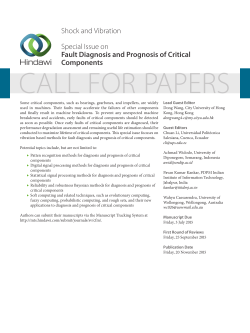
Diagnosis and localization of tracheoesophageal fistula
DIAGNOSIS AND LOCALIZATION OF TRACHEOESOPHAGEAL FISTULA Hagit Levine, Patrick Stafler, Tommy Schonfeld Pulmonary Institute, Schneider Children’s Medical Center Petach-Tikva, Israel Israel Pediatric Pulmonology Society TRACHEOESOPHAGEAL FISTULA • TEF is a common congenital anomaly of the respiratory tract • Incidence of approximately 1 in 3500 live births [Depaepe A, 1993]. • EA and TEF are classified according to their anatomic configuration [BS, 1999]. TRACHEOESOPHAGEAL FISTULA - TEF • Type C: 84%. • H-type: 4 %. [Clark DC. 1999] • H-Type: • Large - May present early: • Coughing/choking associated with feeding. • Smaller defects may not be symptomatic in the newborn. DIAGNOSIS OF TEF+EA • The diagnosis of EA can be made by attempting to pass a catheter into the stomach. DELAY IN DIAGNOSIS OF H-TEF • Delay in diagnosis ranged from 26 days to 4 years [Karnak et al. J Pediatr Surg. 1997]. • Typically have a prolonged history of mild respiratory distress associated with feeding or recurrent episodes of pneumonia. • On occasion, the diagnosis may be delayed for longer periods and even into adulthood [Zacharias J, Melissa Soles et al. Springerplus. 2014]. DIAGNOSIS OF H-TEF • Demonstration with an upper GI using thickened water-soluble contrast material. • The traditional method: A pull-back technique - The distal esophagus is filled first and then the catheter is pulled in a cephalad direction. • Subsequent studies have suggested equal or better diagnostic sensitivity with contrast swallow radiography [Laffan EE et al. Pediatr Radiol. 2006]. PROBLEMS WITH CONTRAST STUDIES 1. The fistulous tract may be missed in these studies. • In the Melbourne study: • 8/30 required 2nd examination. • 2/30 required 3rd examination [Beasley SW, Myers NA. J Pediatr Surg 1988]. 2. When contrast is seen in the airway but the route is obscure. This usually is the result of reflux of contrast up the esophagus and aspiration through the larynx. 3. Tube injection esophagography with child in a prone position becomes increasingly difficult with older children, because of lack of cooperation. CT FOR TEF Compromised ventilation caused by tracheoesophageal fistula and gastrointestinal endoscope undergoing removal of disk battery on esophagus in pediatric patient -A case report- Kim KW, Kim JY, Kim JW, Park JS, Choe WJ, Kim KT, Lee S - Korean J Anesthesiol (2011) 3D CT ESOPHAGOGRAPHY • The use of 3D CT scanning also has been advocated as an additional method for the diagnosis of TEF • CT esophagography demonstrates communication between the middle Intrathoracic esophagus and the distal trachea [Nagata K, Kudo SE. et. Al. World J Gastroenterol. 2006; Islam S, Hirschl RB. Et. Al. J Pediatr Surg. 2004; Dogan BE, Akyar S. et. al. Curr Probl Diagn Radiol. 2005] 3D-CT ESOPHAGEAL ENDOSCOPY • Esophageal endoscopy: • Sometimes demonstration by the appearance in the esophagus of methylene blue that is injected into the trachea. • But in that way the fistula cannot be located. BRONCHOSCOPY • Bronchoscopy can be reliable alternative: • The opening of an isolated TEF is usually small and located on the posterior wall of the trachea at the level of the thoracic inlet within a fold of mucosa TEF - BRONCHOSCOPY But it is easy to overlook a TEF at bronchoscopy. [Crabbe DC. Paediatr Respir Rev. 2003] RECURRENT FISTULA • Complications after EA and TEF repair in a series of 227 cases included: • Anastomotic leak (16%), • Esophageal stricture (35%), • Recurrent fistulae (3%) [Engum SA et al. Arch Surg. 1995]; • Recurrent TEF is a diagnostic challenge. SMALL JETS OF OXYGEN • Olympus bronchoscope 2.8 ,3.8 • Suction valve MAJ-207 • Flow – 2 l/min • Small fast jets of oxygen. • Rate of ~ 1/10 sec. • Low volume. • Low pressure. • Open system. POSITIVE PRESSURE – OPEN SYSTEM • We use a valve that can release positive pressure as needed. • Ensuring air escape to avoid air trapping. • Significant in young children. [Rosen DA et. al. Another use for the suction port on the pediatric flexible bronchoscope. Anesthesiology. 1986] L.E. - REFISTULIZATION AZ.M. H – TEF: UGI 16/10/13 AZ. M. – H - TEF L. 28/11/10 L. UGI 14/11/10 L. CLOSED FISTULA Z.N. 24/4/11 Z.N. – CLOSED FISTULA METHODS Data collected •Files of children with TEF/EA •Bronchoscopy with oxygen jets Imaging •Chest X-RAY •RF Upper GI •CT •MRI •Bronchography Retrospective study Findings • Safety • Efficacy FINDINGS N (%) Total Gender Mean age at proc. 11 Girls 7 (63%) 1.62+1.31y Type TEF/EA C Type - 10 (91%); H Type - 1 (9%) New/Sec Refistulization - 10 (91%); New Fistula - 1 (9%) Reason for bronchoscopy Chest x-ray Infiltrates Recurrent cough 8 (73%); Follow up UGI 3 (27%) 11 (100%) FINDINGS Findings in bronchoscopy with jets Findings in bronchoscopy without jets Positive in UGI Bronchography Complications during Bronchoscopy N (%) Open - 8 (73%) Closed - 4/8 (50%) Positive 10 (91%) Negative 1 (9%) Positive 1 (9%) Negative 1 (9%) 0 (0%) M.A. CASE • PT 34wk VACTER association TEF+EA • Repair surgery at 2 days old • Tracheomalacia + stenosis d/t innominate a. • Aortopexy at 2wk old • At 1 yo refistulization (cough, bronch.) • At 3 yo again cough+infiltrates • 1’st UGI negative M.A. UPGI 9/5/13 M.A. UPGI 16/3/14 M.A. H M.A. M.A. RF UPGI 28/12/14 SUMMARY • Bronchoscopy can be reliable method for diagnosis of TEF. • If the opening of the TEF small it’s easy to overlook. • Small jets of oxygen can be a reliable and safe way for diagnosis of TEF, especially recurrent TEF after repair surgery. • Advantages of this procedure: • Less misdiagnosis • No radiation • No contrast ingested or inhaled • Disadvantages: • Anasthesia • Need skill The end!
© Copyright 2025









